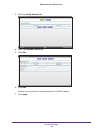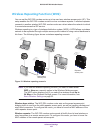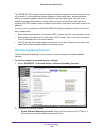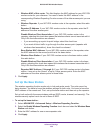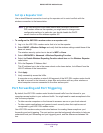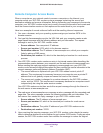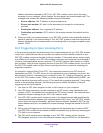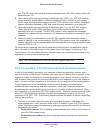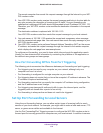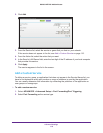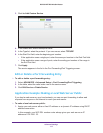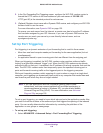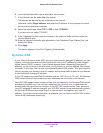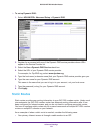
Advanced Settings
114
D6200 WiFi DSL Modem Router
The remote computer then sends this request message through the Internet to your WiFi
DSL modem router.
2. Your WiFi DSL modem router receives the request message and looks in its rules table for
any rules covering the disposition of incoming port 80 traffic. Your port forwarding rule
specifies that incoming port 80 traffic should be forwarded to local IP address 192.168.1.123.
Therefore, your WiFi DSL modem router modifies the destination information in the request
message:
The destination address is replaced with 192.168.1.123.
Your WiFi DSL modem router then sends this request message to your local network.
3. Your web server at 192.168.1.123 receives the request and composes a return message
with the requested web page data. Your web server then sends this reply message to your
WiFi DSL modem router.
4. Your WiFi DSL modem router performs Network Address Translation (NAT) on the source
IP address, and sends this request message through the Internet to the remote computer,
which displays the web page from www.example.com.
To configure port forwarding, you need to know which inbound ports the application needs.
Usually you can determine this information by contacting the publisher of the application or
the relevant user groups and newsgroups.
How Port Forwarding Differs from Port Triggering
The following points summarize the differences between port forwarding and port triggering:
• Port triggering can be used by any computer on your network, although only one
computer can use it at a time.
• Port forwarding is configured for a single computer on your network.
• Port triggering does not require that you know the computer’s IP address in advance. The
IP address is captured automatically.
• Port forwarding requires that you specify the computer’s IP address during configuration,
and the IP address can never change.
• Port triggering requires specific outbound traffic to open the inbound ports, and the
triggered ports are closed after a period of no activity.
• Port forwarding is always active and does not need to be triggered.
Set Up Port Forwarding to Local Servers
Using the port forwarding feature, you can allow certain types of incoming traffic to reach
servers on your local network. For example, you might want to make a local web server, FTP
server, or game server visible and available to the Internet.
Use the Port Forwarding/Port Triggering screen to configure the WiFi DSL modem router to
forward specific incoming protocols to computers on your local network. In addition to servers



